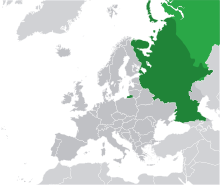
Back روسيا الأوروبية Arabic Rusia europea AST Россиялъул европаялъул бутӀа AV Еўрапейская частка Расіі Byelorussian Европейска част на Русия Bulgarian Rússia europea Catalan ڕووسیای ئەورووپی CKB Rwsia Ewropeaidd Welsh Europæisk Rusland Danish Europäisches Russland German
European Russia | |
|---|---|
| Largest city | Moscow |
| Demonym(s) | Russian |
| Area | |
• Total | 3,969,100 km2 (1,532,500 sq mi) (7th) |
| Population | |
• 2023 estimate | 109,455,000[1] (13th) |
• Density | 27.5/km2 (71.2/sq mi) (160th) |
| GDP (PPP) | 2022 estimate |
• Total | |
• Per capita | |
| GDP (nominal) | 2022[3] estimate |
• Total | |
• Per capita | |
European Russia[a] is the western and most populated part of the Russian Federation. It is geographically situated in Europe, as opposed to the country's sparsely populated and vastly larger eastern part, Siberia, which is situated in Asia, encompassing the entire northern region of the continent. The two parts of Russia are divided by the Ural Mountains and Ural river, bisecting the Eurasian supercontinent. European Russia covers the vast majority of Eastern Europe, and spans roughly 40% of Europe's total landmass, with over 15% of its total population, making Russia the largest and most populous country in Europe. The region is divided into five Federal districts.
- ^ "Оценка численности постоянного населения на 1 января 2024 г. и в среднем за 2023 г. и компоненты ее изменения", rosstat.gov.ru
- ^ Source: PPPs and exchange rates. "Conversion rates - Purchasing power parities (PPP) - OECD Data". Data.oecd.org. Retrieved 2022-03-09.
- ^ Валовой региональный продукт по субъектам Российской Федерации в 1998-2022 гг., rosstat.gov.ru
Cite error: There are <ref group=lower-alpha> tags or {{efn}} templates on this page, but the references will not show without a {{reflist|group=lower-alpha}} template or {{notelist}} template (see the help page).


